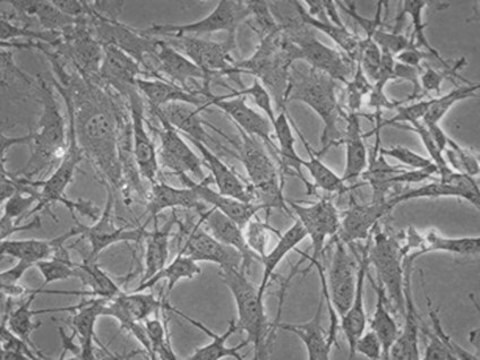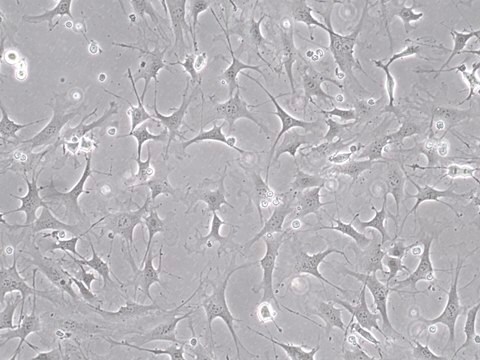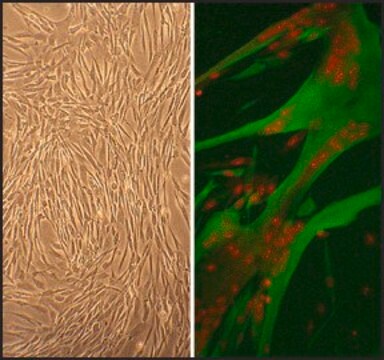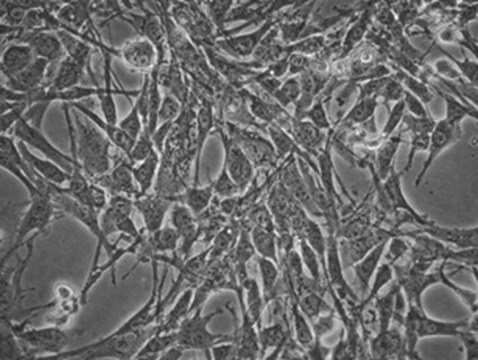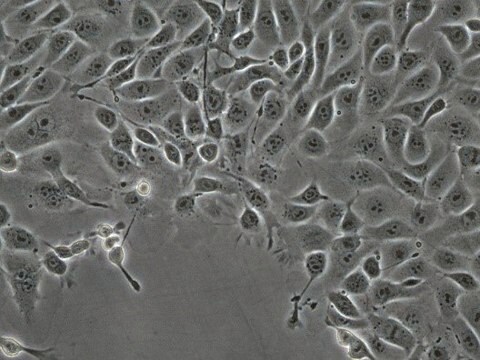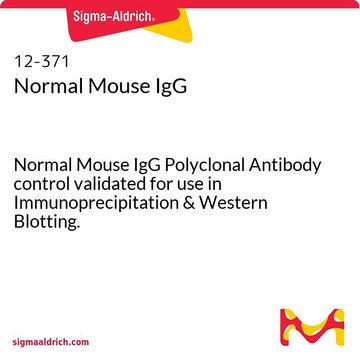SCC136
OP9-DL1 hDL-1-Expressing mOP9 Cell Line
Mouse
Synonym(s):
DL1 cell line, Delta-like 1 cell line, Notch ligand cell line, OP9-DL1, OP9-DL1 cell line
About This Item
Recommended Products
Product Name
OP9-DL1 hDL-1-Expressing mOP9 Cell Line,
biological source
mouse
Quality Level
packaging
vial of ≥1X10⁶ cells/vial vials
manufacturer/tradename
Millipore
technique(s)
cell culture | mammalian: suitable
cell differentiation: suitable
shipped in
liquid nitrogen
storage temp.
−196°C
General description
Notch signaling controls multiple cell fate decisions. It is initiated via engagement of the Notch receptor with its ligands (Jagged or Delta-like family members). This is followed by cleavage of the intracellular domain of Notch and its subsequent translocation into the nucleus, where it binds with the transcription factor CBF-1/RBPJ and activates transcription of various downstream target genes. Upregulation of Notch ligands is a factor in chronic inflammatory diseases including pancreatitis and diabetic nephropathy. Several studies have implicated the role of Notch signaling in early T-cell lineage commitments, as it promotes development of T-cells with αα+ T-Cell Receptors (TCRs) at the expense of αα+ TCRs 3. Bone marrow progenitor cells expressing constitutively active Notch have been shown to develop into CD4 and CD8 double-positive T cells. This signaling pathway also plays an important role in the development of CD4+ or CD8+ single positive cells from CD4 and CD8 double-positive precursor thymocytes.
OP9 bone marrow stromal cells support the differentiation of hematopoietic progenitor cells (HPCs) into multiple lineages including B-cells, but not to T-cells. This is mainly because they do not express Delta-like 1 or Delta-like 4 notch ligands inherently. OP9 cells were therefore infected with a MiGR1 retroviral vector engineered to express the human Delta-like-1 gene and green fluorescent protein (GFP). The OP9-DL1 cells were then sorted for GFP expression.
Source
GMO. OP9-DL1 cells were genetically modified from stromal cells derived from mouse bone marrow.
References
1.Immunity 2002, 17(6): 749-756.
2.J Orthop Sci. 2005, 10(6): 589-594.
3.Curr Opin Immunol. 2007, 19(2): 163-168.
4.Cold Spring Harb Protoc. 2009, 2009(2): pdb.prot5156.
Application
- Each vial contains > 1X106 viable cells.
- Cells are tested negative for infectious diseases by a Mouse Essential CLEAR Panel by Charles River Animal Diagnostic Services.
- Cells are verified to be of mouse origin and negative for interspecies contamination from human, rat, Chinese hamster, Golden Syrian hamster, and nonhuman primate (NHP) as assessed by a Contamination Clear panel by Charles River Animal Diagnostic Services
- Cells are negative for mycoplasma contamination.
Features and Benefits
Storage and Stability
Other Notes
Disclaimer
Storage Class
12 - Non Combustible Liquids
wgk_germany
WGK 3
flash_point_f
Not applicable
flash_point_c
Not applicable
Certificates of Analysis (COA)
Search for Certificates of Analysis (COA) by entering the products Lot/Batch Number. Lot and Batch Numbers can be found on a product’s label following the words ‘Lot’ or ‘Batch’.
Already Own This Product?
Find documentation for the products that you have recently purchased in the Document Library.
Our team of scientists has experience in all areas of research including Life Science, Material Science, Chemical Synthesis, Chromatography, Analytical and many others.
Contact Technical Service